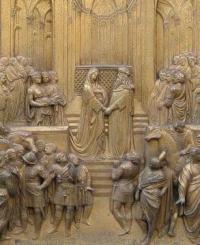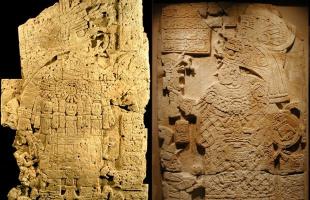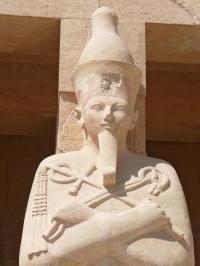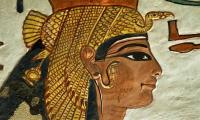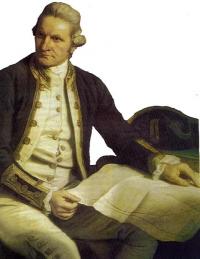Queen Tiye and the co-regency
By Marianne Luban ©

For some years the "Elder Lady" found in the tomb of Amenhotep II (KV35) was conjectured to be Hatshepsut, the female pharaoh, due to the fact that her left arm is raised with fingers poised as if holding some sort of royal scepter. This was, of course, wholly wishful thinking on the part of those caught up in the romance of the great woman king, inspired, perhaps, by the somewhat haughty expression retained on the face of this mummy.
Even haughtier are the severe features on the little head of yew wood long thought to be the quintessential Queen Tiye, foremost consort of Amenhotep III. This wonderfully-executed face was, I believe, chiefly responsible for the experts leaning toward Hatshepsut in the identification of the mummy in question, for there is not much overt resemblance of the mummy to the carving. However, the connection with Tiye was made because a hair sample was taken from the "Elder Lady" to be scientifically compared with strands from a lock discovered in the tomb of the Pharaoh Tutankhamun. The samples were a perfect match. The hair from the tomb was contained in a miniature anthropoid coffin inscribed with the name and titles of Queen Tiye.
As a result of the experiment with the hair, the "Elder Lady" became Queen Tiye, but many had their reservations. Some argued that the mummy had not been old enough at the time of death to be Tiye. In fact, the long, dark hair of this female is entirely without gray. Others maintained a twist of hair in a case with a name on it is far from absolute proof that the lock came from the head of the named individual.
Yet various portraits of Tiye do agree with the face of the mummy. Moreover, it was concluded in a radiological study that x-rays of the skulls of the "Elder Lady" and Thuya, the mother of Queen Tiye, are similar enough to indicate that these mummies are related. As explained by Renate Germer, the blood group of the "Elder Lady" indicates that she could be a daughter of Yuya and Thuya at least theoretically. The blood group for both Yuya and Thuya is A2. However, Germer didn't know whether this meant A2A2 or A2O. In any event, if either Yuya or Thuya happened to have A2A2, then none of their children could have the blood type O, which is what the "Elder Lady" has. If both of the parents had A2O, then the chances of their children having A or O are 3:1 respectively.
As to Tiye's age--that has always been a difficult problem in Egyptology. We have no real idea at all how old Queen Tiye was when she died, although the great Amarna scholar, Cyril Aldred, wrote that, historically, fifty years had to go by between her marriage to king Nebmaatre and her death. The "Elder lady" is hard to pinpoint as well. Because of her hair and other considerations, she has been given the round number of forty, (although Wente and Harris in their "X-ray Atlas" gave her, on the basis of forensic examinations, a minimum age of 25 and a maximum of 35) a rather problematic figure to adjust to the chronology of the life of Queen Tiye, the mother of the heretic pharaoh, Akhenaten. However, age estimates of the mummies have always tended to be on the conservative or low side.
Where, in the absence of the confirmation of DNA testing, does that leave us? In my opinion, the matching of the hair samples itself presents no problems and, of course, cannot be easily disputed. The difficulty lies, perhaps, in our modern reconstruction of the latter part of the 18th Dynasty and the view that has been taken of the reigns of Amenhotep III and his successor, Amenhotep IV or Akhenaten. To be precise, unless we can make a good argument for these two pharaohs having had a co-regency that was more than brief, it remains difficult for us to accept this mummy, the "Elder Lady" as Queen Tiye. Since Tiye and Amenhotep were married sometime prior to his Year 10, it will be necessary for us to come to the conclusion that when Tiye married her king, she was no more than a young girl. Lastly, due to the report of microbiologist, Professor Scott Woodward, that the DNA testing of the royal mummies shows no "outsider blood", we must relinquish the notion that the girl was a commoner and begin to look upon her as being somehow related to the royal family and therefore a suitable and even preferable partner for the king. There is no doubt in my mind, at least, that Thuya, the queen's mother, was of the Thutmosid line as her features are very similar to those of others in this family.
Cyril Aldred took the stance that Amenhotep III and Akhenaten were co-regents for as long as twelve years, a theory that is the best possible one for allowing Queen Tiye to fit the age limitations that the remains, the "Elder Lady" appear to mandate, even so Aldred obviously did not see Tiye as a mere child upon her marriage. Let us postulate, for the sake of this argument, that the Great Durbar of Akhenaten's Year 12 was held because he had finally become sole king of Egypt after twelve years of co-kingship with his father. Then let us propose that Akhenaten was 16 in Year 26 of Amenhotep III when the co-regency began--although it's possible he was even younger--but let us imagine he wasn't born before Year 10 of his father. Tiye had to be older than 12 in Year 10 of her husband because she had already given birth to a son older than Akhenaten named Thutmose and very likely at least one daughter, Sitamun. To be on the safe side we should make her at least sixteen by Year 10 of Amenhotep. Add twenty-eight more years and Tiye becomes forty-four by Year 12 of her son, Akhenaten, which makes her not too old to have had her youngest daughter, Baketaten, who appears as a small girl by her side in the Amarna art. Since Tiye is heard from no more after Year 14 of Akhenaten, she could have died at age forty-six.
However, the archaeological evidence perhaps renders such a lengthy co-regency untenable. An official named Khaemhat had a tomb wherein he shows himself being "given the gold" of approbation by Amenhotep III in the latter's Year 30, a year in which the pharaoh celebrated the first of his three sed festivals. No mention is made in this tomb of Akhenaten. Another official named Ramose also had a tomb prepared about the same time as that of Khaemhat; in fact, the reliefs in both tombs appear to have been carved by the same sculptor. Ramose, in his tomb portraits, has the "juvenilized" face of Amenhotep III (which the king used in his last years),but, for some reason, the pharaoh depicted in Ramose's tomb is Amenhotep IV. Arthur Weigall, therefore, thought work ceased in the unfinished sepulcher of Ramose in the first few years of the reign of the man who later became Akhenaten. Weigall wrote: "In an elaborate shrine sits the young King Amenhotep IV, represented with somewhat boyish features. Behind him sits the goddess Maat." But also "...the names of Amun and Mut, and the word 'gods', have been cut out by the agents of the new religion of Aton, who had instructions from Akhenaten to obliterate the names of the old deities of Egypt. These have been reinstated about the time of Seti Ist after the reversion to the old religion of Amen."
If Weigall is correct in judging the tombs of the two men to be from around the same time, then Akhenaten can have been made king sometime during Year 30 of Amenhotep III. Peter Clayton writes of the latter "Inscribed clay dockets from the Malkata palace carry dates into at least Year 38 of Amenhotep's reign, implying that he may have died in his 39th regnal year...", which means the great pharaoh had eight-plus years of rule remaining.
Aldred mentions some wine jar dockets from Amarna with Years 28 and 30 written on them. He states "Such dates would have referred to a longer reign than that of Akhenaten, who did not found Akhetaten before Year 5 and died in Year 17. The dockets in question must have been written in the reign of Amenophis III, who was the only king of the period to enjoy such a long rule. Their conclusion (British archaeologists Pendlebury and Fairman) was that if the jars had reached Amarna full of wine and properly sealed, the contents must have been at least fourteen years old at the time of delivery; but as wine is presumed not to keep long in permeable pottery jars in a warm climate, they argue that it is most likely that Years 28 and 30 of Amenophis III were near to Year 6 of Akhenaten when Amarna began to be occupied by the official classes."
In reading this last I thought of Weigall and his dating of the two tombs of the officials. Weigall does say that the tomb or mortuary chapel of Ramose was evidently finished by his brother, Amenhotep, as the former seems to have been childless. This tomb, with its magnificently carved reliefs, must have taken quite some time to finish--longer than tombs whose images are merely painted, so it was certainly begun by Ramose while serving the only king with whom he is associated, Amenhotep III. There is no record of Ramose being at Akhetaten. So why does his tomb contain the effigy of Amenhotep IV instead of his sire when the old king is still alive? Another official, Si-mut, who was the Fourth Prophet of Amun in Year 20 of Amenhotep III (and still enjoyed this position in Year 34 during the second jubilee, which was around the time he was elevated to Second Prophet, according to Cyril Aldred), is shown in the tomb of Ramose as being yet Fourth Prophet. Since Si-mut and the other prophets of Amun are only represented in line-drawings and had not been carved in relief, we can assume, probably, that the tomb or mortuary chapel of Ramose saw its last work sometime prior to Year 34 of Amenhotep III. In fact, the tomb may have been viewed by Amenhotep, the vizier's brother, as a possible resting place for himself and, as a result, he continued work on it until about the corresponding Year 4 of the co- regent, Amenhotep IV. Perhaps it was he, as an adherent of this radical young man, who had his own brother's funerary scenes, presided over by the goddesses Isis and Nepthys, carefully plastered over with mud. Finally, Weigall says "Thus in this mortuary chapel we have a complete record of the change of religion and art which caused such an upheaval in Egypt. The chapel was left unfinished, for soon after the fifth and sixth year of the young king's reign the whole court was transferred to Tel el Amarna."
Donald Redford, who does not believe in any sort of co-regency between Nebmaatre and Neferkheperure, however writes that Amenhotep IV celebrated a sed festival of his own by his Year 2 at the latest. Since two years of rule do not seem to warrant a "heb sed", it may be possible to conclude that the future Akhenaten was able to have one by virtue of his being the co-regent of his father during the latter's jubilee--a sort of "mirror heb sed". If this is credible then, indeed, the decoration of Ramose's tomb suddenly takes on a new theme as a commemoration of the young man's accession as co-king. We cannot, as a result, uphold the idea of Pendlebury and Fairman that Year 6 corresponds to Year 30 but must wryly speculate on the possibility of spoiled vintage. However, even wine that is past its "expiration date" is surely still usable for libation offerings to the Aten.
If Akhenaten was born as early as Year 10 of his father, by Year 30 he would have been all of twenty years old and twenty-five when he left to live at Akhetaten for good. Under the circumstances of a co-regency, Akenaten, as he was now called, would have been king over his own city and its inhabitants--and probably little else. According to his last attested regnal year, Amenhotep III dies eight- plus years later at an undetermined age in Year "X" of his heir. But if Year 1 of Akhenaten corresponded to Year 30 of Amenhotep III, which is certainly possible, it can be feasible that Amenhotep III would have died by Year 9 of Akhenaten, making the full-scale reformation possible at that time and certainly the Great Durbar in Year 12 where the nations now show their fealty to the son instead of the father. One might say that if Amenhotep IV was the king who was portrayed in the tomb of Ramose, perhaps it was already Year 38 or 39 of Amenhotep III and the old king had died. But I say this scenario is not likely because Si-mut is still shown as Fourth Prophet in the last stages of decoration of this tomb and he was promoted to Second Prophet in Year 34, a jubilee year. Aldred writes of this man: "It would appear that Si-mut was responsible for building projects at Western Thebes about this time and was probably charged with preparing the tomb of Ramose to receive the vizier's burial. He took the opportunity of earning a little immortality on his own by distinguishing his fully-revealed figure on the south wall of the main hall by adding his name to it and the epithet 'justified' for good measure, just as he did on a door-jamb at the temple of Amun in the Malkata palace. Thus, when he finished off the painting of the south wall (of Ramose's tomb) he had not yet reached the crown of his career, and the reign of Amenhotep III still had some years to run."
I don't think we can allow twelve years of co-regency, but nine certainly seems possible.
And Queen Tiye? Once again, if she was sixteen years old in Year 10 of her husband, Amenhotep III, she would have been forty-four or forty-five in his last year. This would have been, taking into consideration nine overlapping years, Year 9 of her son, Akhenaten. Most probably, the great lady died five years later in Year 14 of this king, at the age of forty-nine or fifty. While it is relatively rare for a person of these years to have a full head of dark hair without gray, it is certainly not impossible, and a set of fairly good teeth is also not beyond imagination. The diminutive mummy called the "Elder Lady" may cause us to wonder about her true identity for some time to come, but there is no doubt about one thing, at least in my mind. This was once a lovely woman whose strong character is as plainly written on her face in death as it surely was in life.
BIBLIOGRAPHY
- Weigall, Arthur, "A Guide To the Antiquities of Egypt" (1910) London
- Aldred, Cyril, "Akhenaten, King of Egypt" (1988) New York
- Redford, Donald, "Akhenaten the Heretic King" (1987) New Jersey
- Wente, Edward F. & Harris, James E., "An X-ray Atlas of the Royal Mummies" (1980) Chicago
- Clayton, Peter, " Chronicle of the Pharaohs" (1994) London
- Germer, Renate, "Die Angebliche Mumie Der Teje: Probleme Interdisziplinarer Arbeiten" SAK II: 85-90










